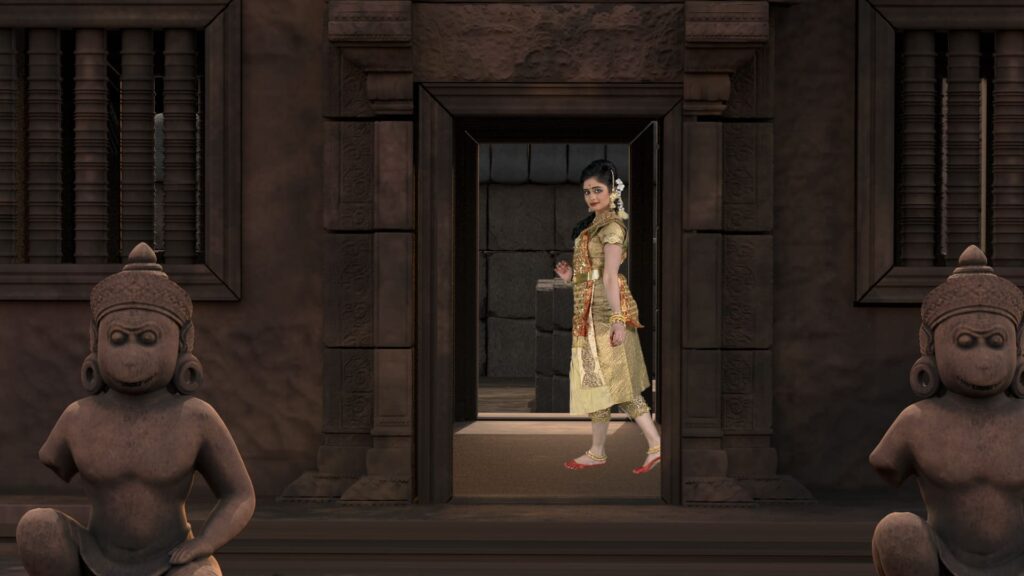Monuments, architecture, music, costume, lighting and imagination intersect in this production called AMARA by Apsaras Arts. An interview with its creator, Aravinth Kumarasamy
Aravinth, what was the genesis of this production? When it was born, how did it develop? What is the kind of research that went into this?
In 2013, I had conceptualised a dance theatre production ANGKOR – An Untold Story which was based on the historical details and events on how this grand monument in Cambodia was built by the Khmers. As part of the research for this production, we had also studied, researched and visited Banteay Srei, a smaller and earlier monument to Angkor Wat in Cambodia. A brief description of this monument was included in the narrative of the production of Angkor. In 2020, during the lockdown due to the pandemic, we decided to work on a digital dance film using CGI technology, and at that time, we decided to tell the stories carved on the walls of Banteay Srei through dance and music. The earlier research done was handy and further details of the monument were researched.
Banteay Srei has some interesting details which inspired us to write lots of stories, like the following:
- The famous Khmer temple, Banteay Srei, was built by Yajnavaraha, a Brahmana priest, who served during the reigns of Khmer kings Rajendravarman and Jayavarman V. According to the stele inscription of Banteay Srei, work on its construction began in 967 CE and Yajnavaraha’s brother, Visnukumara, is also mentioned as a co-patron.
- Banteay Srei was the only major temple at Angkor not built by a ruler..
- The original name of this temple was Sri Tribhuvanamahesvara (lord of the 3 worlds).
- The temple’s modern name, Banteay Srei, citadel of women is due to intricate bas-relief carvings that can be found on the walls as well as the tiny dimensions of the structures themselves.
- The temple got its name from the fact that it has many Yoginis (female deities) carved into the walls of the structures.
The Jewel of Khmer Architecture:
Due to the miniature size of the structures, uniqueness of the tiny details, and exceptional refinement of the sculptures, it is popularly admired as a ‘Precious Gem’, or the ‘Jewel of Khmer Art.’









- The work relates more closely to the art of the goldsmith or to carving in wood than to sculpture in stone. The very nature of the material used, a hard red sandstone that can be worked like wood. The temple walls were frequently perfumed with sandalwood oil to be fragrant Stories carved on its walls
- At this temple, lintels appear with stories from the Mahabharata, the Ramayana, and the Puranas relating to themes associated with Saivism and Vaishnavism.
Can you give us an insight on the Aharya abhinaya, especially for this production.
Mohanapriyan Thavarajah, worked on creating a Cambodian inspired costume, accessories and hairstyling of the dancers. The dancers take on the role of the yoginis who were celebrated in this temple, hence we gave them an appearance of divine Cambodian demi-gods. The challenge was to create all the costumes in Singapore itself as we could not travel to India or to any international destination due to the pandemic.
Singapore had all the required Cambodian fabrics, however, we had to get tailors who make regular sari blouses to make dance costumes. Mohanapriyan spent many hours sitting alongside the tailors to get this done for their entire cast of eight dancers.
What about the music? Why is the music of Amara unique? Were there lyrics specially written for the theme?
Dr Rajkumar Bharathi and Sai Sharavanam created the original music score and got it recorded in Chennai working remotely and online with me. This was the first time where we were not in the studio to discuss, or be present when the music was being recorded.
Rajkumar Bharathi created exclusive compositions for Amara which resonated with the beauty of the monument and the secrets it held within.
How have you drawn parallels with the Khmer regime and the Indian subcontinent? This attempt to identify connections and linkages is crucial to the work of Apsaras Arts, right?
I have been inspired by the diverse cultures of Southeast Asia and its roots with Indian culture and Hindu concepts and legends. Amara is also along the line of our exploration at Apsaras Arts to bring cultures together . Banteay Srei contains details of bas relief carvings on many Hindu stories, which Amara brings to life through dance.
My two favourites are:
- This carving is in the southern gallery. In this carving, Siva is seated on the mountain Kailash, his home with his consort Parvati. The mountain is presented by titering. Each tier has people and animals who are very panicked. In the middle of the carving presenting the demon king Ravana with ten heads and twenty arms. He is shaking the mountain which Siva is sitting on. Siva uses his toe to press the mountain down and traps Ravana under the mountain for more than a thousand years.
- In this lintel, Shiva Nataraja is shown as the cosmic dancer who performs his divine dance to destroy a weary universe so that Brahma may start the process of creation. At the lower edges are a drummer providing the music and Karaikkal Ammaiyar, Shiva’s disciple, a celebrated saint from Tamil Nadu.
Mohanapriyan has done a wonderful job of choreographing these stories and the cast of dancers brought each carving alive through their dance.
How has the architectural beauty of Bantaey Srei been captured in this production? What is Apsaras Arts’ fascination with capturing architecture onto stage in the form of dance?
Monuments have been my fascination for a long time. In 2010, my journey started exploring architecture through the production Nirmanika, then Angkor, followed by Anjasa and then with Amara. Each of them brings out different aspects of the architectural marvels of the monuments. In Amara, the audience sees the bas reliefs come alive.









